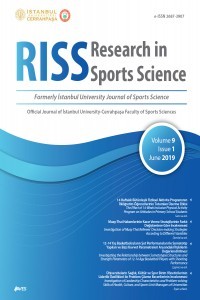Futbolcularda Yaralanma Önleme Programları (Derleme)
-
Injury Prevention Programs in football (Review)
-,
___
- Alentorn-Geli E, Myer GD, Silvers HJ, Samitier G, Romero D, Lazaro-Haro C, Cugat R. Prevention of non-contact an- terior cruciate ligament injuries in soccer players. Part 1 : Mechanisms of injury and underlying risk factors. Knee Surg Sports Traumotol Arthrosc (2009) 17:705-729
- Alentorn-Geli E, Myer GD, Silvers HJ, Samitier G, Romero D, Lázaro-Haro C, Cugat R. Prevention of non-contact ante- rior cruciate ligament injuries in soccer players. Part 2: a re- view of prevention programs aimed to modify risk factors and to reduce injury rates. Knee Surg Sports Traumatol Arthrosc. 2009 Aug;17(8):859-79.
- Bahr R, Krosshaug T. Understanding injury mechanisms: a key component of preventing injuries in sport. British Jour- nal of Sports Medicine (2005) 39:324-329
- Caine D. et al. Epidemiology of Injury in Child and Adoles- cent Sports : Injury Rates, Risk Factors, and Prevention. Clin Sports Med 27 (2008) 19-50
- Emery CA, Meeuwisse WH, Hartmann SE. Evaluation of Risk Factors for Injury in Adolescent Soccer: Implementation and Validation of an Injury Surveillance System. Am J Sports Med. 2005 Dec;33(12):1882-91.
- Emery CA, Meeuwisse WH, McAllister JR. Survey of sport participation and sport injury in Calgary and area high scho- ols. Clin J Sport Med 2006;16:20–6.
- Finch C, Lloyd D, Elliott B. The Preventing Australian Foo- tball Injuries with Exercise (PAFIX) Study: a group randomi- sed controlled trial. Inj Prev. 2009 Jun;15(3):e1.
- Inklaar H. Soccer injuries. I: Incidence and severity. Sports Med 1994;18:55-73
- InklaarH, Bol E, Schmikli SL, Mosterd WL. Injuries in male soccer players: team risk analysis. Int J Sports Med. 1996;17:229-234
- J Brito, P Figueiredo, L Fernandes, A Seabra, J M Soares, P Krustrup, A Rebelo. Isokinetic strength effects of FIFA’s “The 11+” injury prevention training programme. Isokinetics and Exercise Science 2010, 18:211–215.
- Lysens R, Steverlynck A, van den Auweele Y, et al. The predictability of sports injuries. Sports Med 1984;1:6–10.
- Peterson L, Junge A, Chomiak J, Graf-Baumann T, Dvo- rak J. Incidence of football injuries and complaints in diffe- rent age groups and skill level groups. Am J Sports Med. 2000;28:S51-S57
- Rahnama N. Preventing Sport Injuries : Improving Perfor- mance. Int J Prev Med. 2012 March; 3(3): 143-144.
- Sandor L. Schmikli, Wouter R. de Vries, Han Inklaar, Frank J.G. Backx. Injury prevention target groups in soccer: Injury characteristics and incidence rates in male junior and senior players. Journal of Science and Medicine in Sport 14 (2011) 199–203
- Soligard T, Myklebust G, Steffen K, Holme I, Silvers H, Bizzini M, Junge A, Dvorak J, Bahr R, Andersen TE. Comp- rehensive warm-up programme to prevent injuries in young female footballers: cluster randomised controlled trial. BMJ. 2008 Dec 9;337:a2469.
- Van Beijsterveldt AM, van de Port IG, Krist MR, Schmikli SL, Stubbe JH, Frederiks JE, Backx FJ. Effectiveness ofan injuryprevention programme for adult male amateur soc- cer players: a cluster-randomised controlled trial. Br J Sports Med. 2012 Aug 22.
- Başlangıç: 2019
- Yayıncı: İstanbul Üniversitesi-Cerrahpaşa
6-11 Yaş Grubu İlköğretim Çağı Hareketli ve Hareketsiz Çocuklarda Obezite Prevelansının Belirlenmesi
Suzan DAL, İlhan ODABAŞ, Nalan SUNA, Çiğdem BULGAN, Selda AKKAYA
Yeşer Eskicioğlu, Gazanfer Doğu, Selami Özsoy
Elektriksel Kas Uyarılarına Karşı Tolerans Gelişimi
Güreş Eğitim Merkezlerindeki 12-16 Yaş Sporcuların Motivasyonel Faktörlerinin İncelenmesi
Futbolcularda Yaralanma Önleme Programları (Derleme)
Mehmet Öztürk, Hanife Ataman Yancı, Ayşe Türksoy, Evren Yıldız
